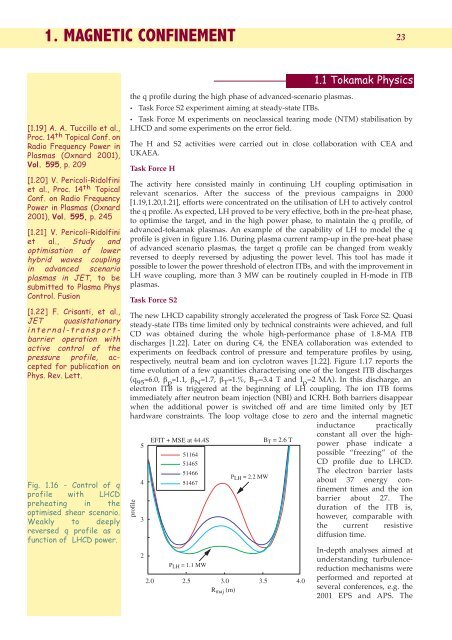1. magnetic confinement - ENEA - Fusione
1. magnetic confinement - ENEA - Fusione
1. magnetic confinement - ENEA - Fusione
Create successful ePaper yourself
Turn your PDF publications into a flip-book with our unique Google optimized e-Paper software.
<strong>1.</strong> MAGNETIC CONFINEMENT<br />
23<br />
[<strong>1.</strong>19] A. A. Tuccillo et al.,<br />
Proc. 14 th Topical Conf. on<br />
Radio Frequency Power in<br />
Plasmas (Oxnard 2001),<br />
Vol. 595, p. 209<br />
[<strong>1.</strong>20] V. Pericoli-Ridolfini<br />
et al., Proc. 14 th Topical<br />
Conf. on Radio Frequency<br />
Power in Plasmas (Oxnard<br />
2001), Vol. 595, p. 245<br />
[<strong>1.</strong>21] V. Pericoli-Ridolfini<br />
et al., Study and<br />
optimisation of lower<br />
hybrid waves coupling<br />
in advanced scenario<br />
plasmas in JET, to be<br />
submitted to Plasma Phys<br />
Control. Fusion<br />
the q profile during the high phase of advanced-scenario plasmas.<br />
• Task Force S2 experiment aiming at steady-state ITBs.<br />
• Task Force M experiments on neoclassical tearing mode (NTM) stabilisation by<br />
LHCD and some experiments on the error field.<br />
The H and S2 activities were carried out in close collaboration with CEA and<br />
UKAEA.<br />
Task Force H<br />
<strong>1.</strong>1 Tokamak Physics<br />
The activity here consisted mainly in continuing LH coupling optimisation in<br />
relevant scenarios. After the success of the previous campaigns in 2000<br />
[<strong>1.</strong>19,<strong>1.</strong>20,<strong>1.</strong>21], efforts were concentrated on the utilisation of LH to actively control<br />
the q profile. As expected, LH proved to be very effective, both in the pre-heat phase,<br />
to optimise the target, and in the high power phase, to maintain the q profile, of<br />
advanced-tokamak plasmas. An example of the capability of LH to model the q<br />
profile is given in figure <strong>1.</strong>16. During plasma current ramp-up in the pre-heat phase<br />
of advanced scenario plasmas, the target q profile can be changed from weakly<br />
reversed to deeply reversed by adjusting the power level. This tool has made it<br />
possible to lower the power threshold of electron ITBs, and with the improvement in<br />
LH wave coupling, more than 3 MW can be routinely coupled in H-mode in ITB<br />
plasmas.<br />
Task Force S2<br />
[<strong>1.</strong>22] F. Crisanti, et al.,<br />
The new LHCD capability strongly accelerated the progress of Task Force S2. Quasi<br />
JET quasistationary<br />
steady-state ITBs time limited only by technical constraints were achieved, and full<br />
internal-transportbarrier<br />
operation with<br />
CD was obtained during the whole high-performance phase of <strong>1.</strong>8-MA ITB<br />
discharges [<strong>1.</strong>22]. Later on during C4, the <strong>ENEA</strong> collaboration was extended to<br />
active control of the<br />
experiments on feedback control of pressure and temperature profiles by using,<br />
pressure profile, accepted<br />
for publication on<br />
respectively, neutral beam and ion cyclotron waves [<strong>1.</strong>22]. Figure <strong>1.</strong>17 reports the<br />
time evolution of a few quantities characterising one of the longest ITB discharges<br />
Phys. Rev. Lett.<br />
(q 95 ≈6.0, β p ≈<strong>1.</strong>1, β N ≈<strong>1.</strong>7, β T ≈<strong>1.</strong>%, B T =3.4 T and I p =2 MA). In this discharge, an<br />
electron ITB is triggered at the beginning of LH coupling. The ion ITB forms<br />
immediately after neutron beam injection (NBI) and ICRH. Both barriers disappear<br />
when the additional power is switched off and are time limited only by JET<br />
hardware constraints. The loop voltage close to zero and the internal <strong>magnetic</strong><br />
inductance practically<br />
constant all over the highpower<br />
phase indicate a<br />
EFIT + MSE at 44.4S<br />
B T = 2.6 T<br />
5<br />
51164<br />
possible “freezing” of the<br />
51465<br />
CD profile due to LHCD.<br />
51466<br />
The electron barrier lasts<br />
P LH = 2.2 MW<br />
about 37 energy <strong>confinement</strong><br />
times and the ion<br />
Fig. <strong>1.</strong>16 - Control of q<br />
4<br />
51467<br />
profile with LHCD<br />
barrier about 27. The<br />
preheating in the<br />
duration of the ITB is,<br />
optimised shear scenario.<br />
however, comparable with<br />
Weakly to deeply 3<br />
the current resistive<br />
reversed q profile as a<br />
diffusion time.<br />
function of LHCD power.<br />
profile<br />
2<br />
2.0<br />
P LH = <strong>1.</strong>1 MW<br />
2.5<br />
3.0<br />
R maj (m)<br />
3.5 4.0<br />
In-depth analyses aimed at<br />
understanding turbulencereduction<br />
mechanisms were<br />
performed and reported at<br />
several conferences, e.g. the<br />
2001 EPS and APS. The













